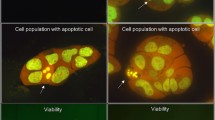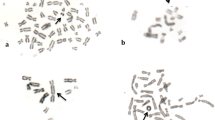Summary
The medicinal use of Aristolochia clematitis has been known for some time. The main active agent of this medicinal plant is aristolochic acid, a nitrophenanthrenecarbonic acid. Very recently, however, the Federal Health Office withdrew the licence for all drugs containing aristolochic acid, because of the well-founded suspicion that aristolochic acid may be a very potent carcinogen.
We investigated the induction of structural chromosome aberrations and sister chromatid exchanges (SCEs) by aristolochic acid in human lymphocytes in vitro. Cells were treated with the agent tested throughout culture time and during the G0 phase of the cell cycle. We tested concentrations over a range of 1 to 20 μg/ml. Both treatment conditions resulted in an increased aberration frequency. The induction of gaps and breaks as well as the induction of SCEs showed a dose-dependent increase. The number of SCEs per metaphase was enhanced by a factor of 2 to 3. If conventional cytogenetic methods had been applied in time, one would have recognized the mutagenic risk of aristolochic acid earlier.
Similar content being viewed by others
References
Bundesgesundheitsamt (1981) Zum Zulassungswiderruf Aristolochiasäure-haltiger Fertigarzneimittel. Pharm Z 126:1373–1374
Cohen MM, Sagi M (1979) The effect of nitrofurans on mitosis, chromosome breakage and sister chromatid exchanges in human peripheral lymphocytes. Mutat Res 59:139–142
Dresp J, Schmid E, Bauchinger M (1978) The cytogenetic effect of bleomycin on human peripheral lymphocytes in vitro and in vivo. Mutat Res 56:341–353
Grossgebauer K, Raettig H, Langmaack H, Küchler R (1970) Zur unspezifischen Schutzwirkung von Lysozym und Aristolochiasäure bei bakteriellen und viralen Infektionen. Zentralbl Bakteriol [Naturwiss] 213:401–408
Ikushima T, Wolff S (1974) Sister chromatid exchanges induced by light flashes to 5-bromodeoxyuridine and 5-iododeoxyuridine-substituted Chinese hamster chromosomes. Exp Cell Res 87:15–19
Lemperle G (1977) Die Aristolochiasäure in der praktischen Chirurgie unter besonderer Berücksichtigung der Wirkung auf das RES. Symposium Der chronische Infekt. Fortbildungsreferat der Ärztekammer, Wien
Möse JR (1963) Versuche über die Wirksamkeit von Aristolochiasäure. Planta Med 11:72–91
Möse JR (1966) Weitere Untersuchungen über die Wirkung der Aristolochiasäure. Arzneimittelforsch 16:118–122
Möse JR, Stünzner D, Zirm M, Egger-Büssing Ch, Schmalzl F (1980) Experimentelle Beeinflussung der Herpes simplex-Infektion des Kaninchen-Auges durch Aristolochiasäure. Arzneimittelforsch 30: 1571–1573
Nachtman JP (1982) Activity of nitro-polynuclear aromatic hydrocarbons in the sister chromatid exchange assay with and without metabolic activation. Environ Mutagen 4:1–5
Perry P, Wolff S (1974) New Giemsa method for the differential staining of sister chromatids. Nature 251:156–158
Robisch G, Schimmer O, Göggelmann W (1982) Aristolochic acid is a direct mutagen in Salmonella typhimurium. Mutat Res 105:201–204
Schulz M, Weist F, Gemählich M (1971) Dünnschichtchromatographischer Nachweis der Aristolochia-Säure in verschiedenen Körperflüssigkeiten. Arzneimittelforsch 21:934–936
Schunack W, Mutschler E, Rochelmeyer H (1967) Über das Vorkommen der Aristolochiasäuren I und II in Aristolochia clematitis L. in Abhängigkeit von Jahreszeit und Standort. Pharmazic 22:118–120
Tamura H, Sugiyama Y, Sugahara T (1974) Effect of bleomycin on the chromosomes of human lymphocytes at various cell phases. Gann 65:103–107
Tokiwa H, Nakagawa R, Ohnishi Y (1981) Mutagenicity of nitroderivatives induced by exposure of aromatic compounds to nitrogen dioxide. Mutat Res 85:195–205
Vig BK, Lewis R (1978) Genetic toxicology of bleomycin. Mutat Res 55:121–145
Winkler K (1977) Die Aristolochiasäure in der Dermatologie. Symposium Der chronische Infekt. Fortbildungsreferat der Ärztekammer Wien
Author information
Authors and Affiliations
Rights and permissions
About this article
Cite this article
Abel, G., Schimmer, O. Induction of structural chromosome aberrations and sister chromatid exchanges in human lymphocytes in vitro by aristolochic acid. Hum Genet 64, 131–133 (1983). https://doi.org/10.1007/BF00327108
Received:
Revised:
Issue Date:
DOI: https://doi.org/10.1007/BF00327108




